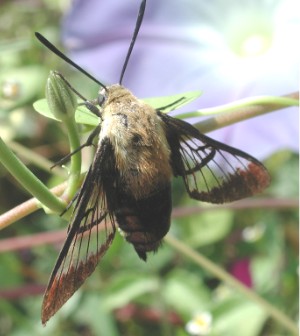
Hemaris is a genus of sphinx moths in the subfamily Macroglossinae, which is native to the Holarctic. Their main host plants are herbs and shrubs of the teasel and honeysuckle families. Moths in genus Hemaris are known collectively as clearwing moths or hummingbird moths in the US and Canada and bee hawk-moths in Britain. The related Old World hummingbird hawk-moths, genus Macroglossum, are similar in appearance and habits. Both genera have tails that are provided with an expansile truncated tuft of hairs, but only Hemaris has the disc of the wings transparent, as these scales are dropped soon after eclosion.

Hemaris diffinis, the snowberry clearwing, is a moth of the family Sphingidae. This moth is sometimes called "hummingbird moth" or "flying lobster". This moth should not be confused with the hummingbird hawk-moth of Europe.

Hemaris tityus, the narrow-bordered bee hawk-moth, is a moth of the family Sphingidae which is native to the Palearctic.
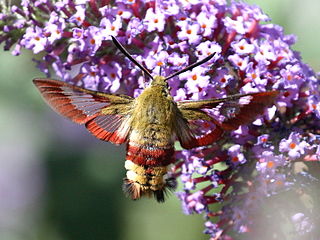
Hemaris fuciformis, known as the broad-bordered bee hawk-moth, is a moth of the family Sphingidae.

Hemaris thetis, the Rocky Mountain clearwing or California clearwing, is a moth of the family Sphingidae. The species was first described by Jean Baptiste Boisduval in 1855. It is found from Colorado, New Mexico, Montana, Idaho, Wyoming and Utah west to California and north to British Columbia. The habitat consists of streamsides and meadows in mountainous areas.

Hemaris gracilis, the slender clearwing or graceful clearwing, is a moth of the family Sphingidae. The species was first described by Augustus Radcliffe Grote and Coleman Townsend Robinson in 1865.

Hemaris croatica is a moth of the family Sphingidae. It was described by Eugenius Johann Christoph Esper in 1800.
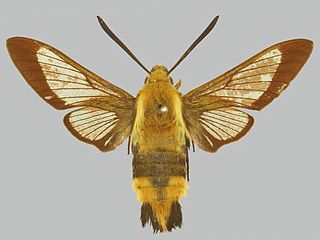
Hemaris affinis, the honeysuckle bee hawkmoth, is a moth of the family Sphingidae. It is known from Mongolia, the Russian Far East, northern, central and eastern China, Taiwan, North Korea, South Korea and Japan.

Hemaris beresowskii is a moth of the family Sphingidae. It is known from south-western China.

Hemaris ducalis, the Pamir bee hawkmoth, is a moth of the family Sphingidae. It is known from the mountains of south-western Xinjiang in China, the western Tian Shan, southern and eastern Kazakhstan up to the Altai Mountains, western Mongolia, southern Uzbekistan, Kyrgyzstan, Tajikistan, northern Afghanistan and Pakistan.

Hemaris ottonis is a moth of the family Sphingidae. It is known from the Russian Far East, north-eastern China and the Korean Peninsula.
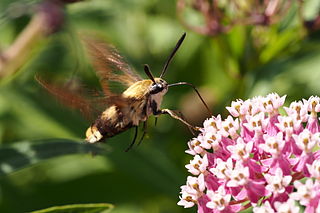
Hemaris radians is a moth of the family Sphingidae. It is known from southern Siberia, Mongolia, the southern Russian Far East, north-eastern and central-eastern China, the Korean Peninsula and Japan.
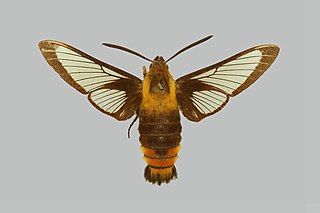
Hemaris staudingeri is a moth of the family Sphingidae. It is found from eastern and central China north to the southern part of the Russian Far East.

Hemaris alaiana, the Alai bee hawkmoth, is a moth of the family Sphingidae. The species was first described by Walter Rothschild and Karl Jordan in 1903. It is known from the Alayskiy Khrebet, Tian Shan, Dzungarian Alatau, Saur and Altai mountains, from Tajikistan and eastern Kazakhstan to western Mongolia. The habitat consists of montane meadows and woodland glades rich in flowers, generally from 1,400 to 2,200 meters altitude.
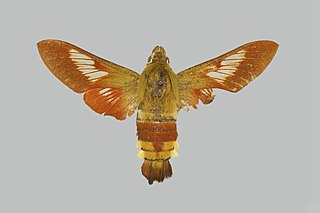
Hemaris dentata, the Anatolian bee hawkmoth, is a moth of the family Sphingidae. The species was first described by Otto Staudinger in 1887. It is known from southern Turkey as far west as the Taurus Mountains.
Hemaris syra, the broad-bordered bee hawkmoth, is a moth of the family Sphingidae. The species was first described by Franz Daniel in 1939. It is known from southern and eastern Turkey, the western Zagros Mountains and northern Alborz Mountains of Iran, the Kopet Dag mountains of Turkmenistan, western Jordan, and northern Israel. The habitat consists of open remnants of former woodland, especially where Lonicera grows through and over low shrubs. It occurs at around 1,000 meters altitude in southern Turkey and from 1500 to 1600 meters in northern Israel.

Hemaris rubra, the Kashmir bee hawkmoth, is a moth of the family Sphingidae. The species was first described by George Hampson in 1893. It is known from a number of valleys in Kashmir. The habitat consists of flower-rich meadows at around 2,500 meters.

Hemaris saundersii, or Saunders' bee hawkmoth, is a moth of the family Sphingidae. The species was first described by Francis Walker in 1856. It is found from southern Kashmir, northern Pakistan, northern India and north-eastern Afghanistan, eastwards along the Himalayan foothills of India to Bangladesh and northern Myanmar. The habitat consists of scrub-jungle at 1,800 to 3,000 metres altitude.
Hemaris galunae is a moth of the family Sphingidae. The species was first described by Ulf Eitschberger, Günter C. Müller and Vasiliy D. Kravchenko in 2005. It is known from Syria.
Hemaris molli is a moth of the family Sphingidae. The species was first described by Ulf Eitschberger, Günter C. Müller and Vasiliy D. Kravchenko in 2005. It is known from Jordan.
















